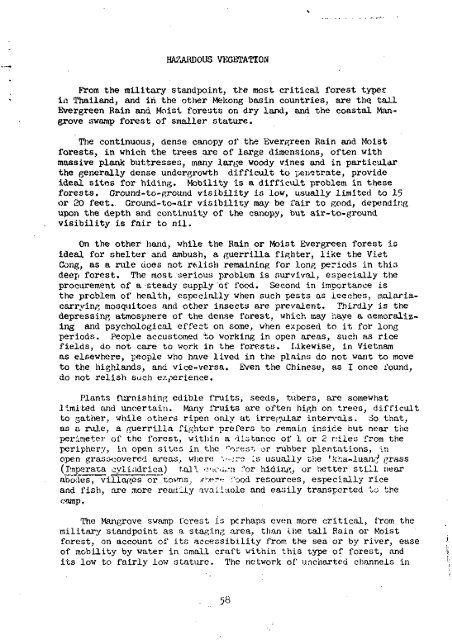Vegetation of Southeast Asia Studies of Forest Types 1963-1965
Vegetation of Southeast Asia Studies of Forest Types 1963-1965
Vegetation of Southeast Asia Studies of Forest Types 1963-1965
Create successful ePaper yourself
Turn your PDF publications into a flip-book with our unique Google optimized e-Paper software.
HAZARDOUS VEGETATION<br />
From the military standpoint, tre most critical forest types<br />
in Thailand, and in the other Mekong basin countries, are thq taJ.l<br />
Evergreen Rain and Moist forests on dry land, and the coastal Mangrove<br />
swamp forest <strong>of</strong> smaller stature.<br />
The continuous, dense canopy <strong>of</strong> the Evergreen Rain and Moist<br />
forests, in which the trees are <strong>of</strong> large dimensions, <strong>of</strong>ten with<br />
massive plank buttresses, many large woody vines and in particular<br />
the generally dense undergrowth difficult to i^n^trate, provide<br />
ideal sites for hiding. Mobility is a difficult problem in these<br />
forests. Ground-to-ground visibility is low, usually limited to 15<br />
or 20 feet. Ground-to-air visibility may be fair to good, depending<br />
upon the depth and continuity <strong>of</strong> the canopy, but air-to-ground<br />
visibility is fair to nil.<br />
On the other hand, while the Rain or Moist Evergreen forest is<br />
ideal for shelter and ambush, a guerrilla fighter, like the Viet<br />
Cong, as a rule does not relish remaining for long periods in this<br />
deep forest. The most/serious problem is survival, especially the<br />
procurement <strong>of</strong> a steady supply <strong>of</strong> food. Second in importance is<br />
the problem <strong>of</strong> health, especially when such pests as leeches, malariacarrying<br />
mosquitoes and other insects are prevalent. Thirdly is the<br />
depressing atmosphere <strong>of</strong> the dense forest, which may have a demoralizing<br />
and psychological effect on some, when exposed to it for long<br />
periods. People accustomed to working in open areas, such as rice<br />
fields, do not care to work in the forests. Likewise, in Vietnam<br />
as elsewhere, people who have lived in the plains do not want to move<br />
to the highlands, and vice-versa. Even the Chinese, as I once found,<br />
do not relish such experience.<br />
Plants furnishing edible fruits, seeds, tubers, are somewhat<br />
limited and uncertain. Many fruits are <strong>of</strong>ten high on trees, difficult<br />
to gather, while others ripen only at irregular intervals. So that,<br />
as a rule, a guerrilla fighter prefers to remain inside but near the<br />
perimeter <strong>of</strong> the forest, within a distance <strong>of</strong> 1 or 2 niles from the<br />
periphery, in open sites in the r orean or rubber plantations, in<br />
open gras&covered areas, where v.-:re Is usually the 'kha-luan/f grass<br />
(T'.npgrata oylindrica) tall .•.vu.-.i.-'n :"or hiding, or better still near<br />
abcxfes, villages or towns, /r-.er^ food resources, especially rice<br />
and fish, are more readily avaiiaole and easily transported to the<br />
camp,<br />
The Mangrove swamp forest is perhaps even more critical, from the<br />
military standpoint as a staging area, than the tall Rain or Moist<br />
forest, on account <strong>of</strong> its accessibility from the sea or by river, ease<br />
<strong>of</strong> mobility by water in email craft within this type <strong>of</strong> forest, and<br />
its low to fairly low stature. The network <strong>of</strong> uncharted channels in
















